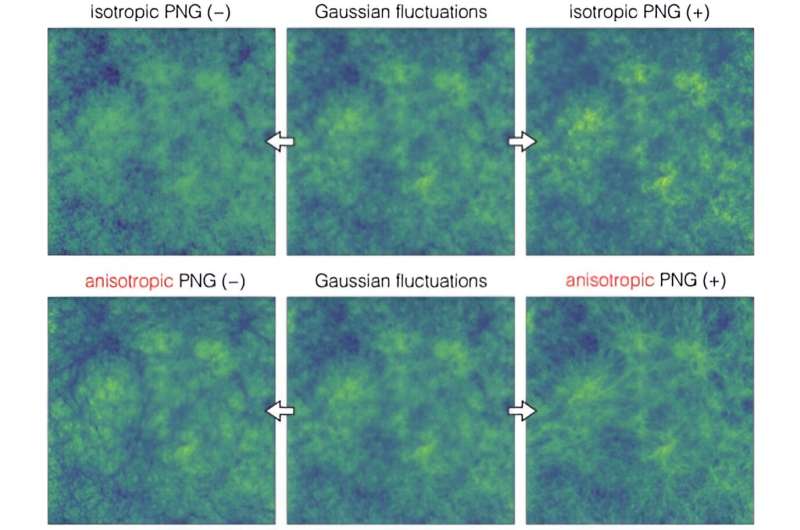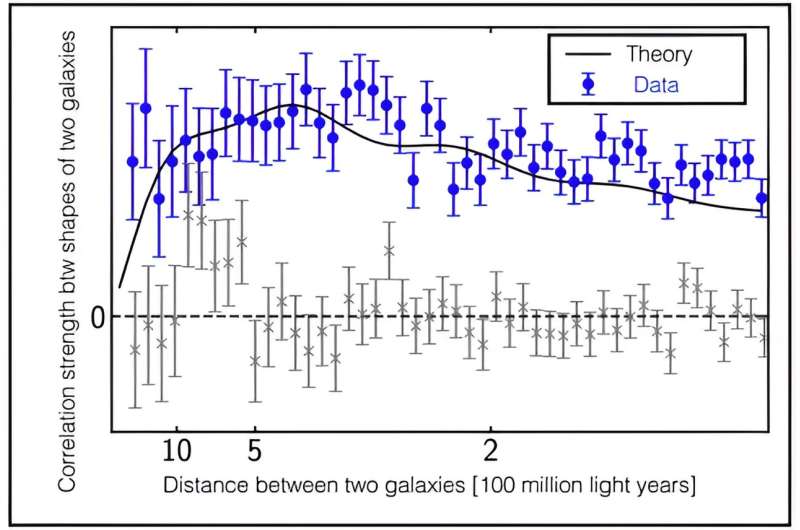by Kavli Institute for the Physics and Mathematics of the Universe, The University of Tokyo
A team of researchers has analyzed more than 1 million galaxies to explore the origin of the present-day cosmic structures, as reported in a recent study published in Physical Review D as an Editors’ Suggestion.
Until today, precise observations and analyses of the cosmic microwave background (CMB) and large-scale structure (LSS) have led to the establishment of the standard framework of the universe, the so-called ΛCDM model, where cold dark matter (CDM) and dark energy (the cosmological constant, Λ) are significant characteristics.
This model suggests that primordial fluctuations were generated at the beginning of the universe, or in the early universe, which acted as triggers, leading to the creation of all things in the universe including stars, galaxies, galaxy clusters, and their spatial distribution throughout space. Although they are very small when generated, fluctuations grow with time due to the gravitational pulling force, eventually forming a dense region of dark matter, or a halo. Then, different halos repeatedly collided and merged with one another, leading to the formation of celestial objects such as galaxies.
Since the nature of the spatial distribution of galaxies is strongly influenced by the nature of the primordial fluctuations that created them to begin with, statistical analyses of galaxy distributions have been actively conducted to observationally explore the nature of primordial fluctuations. In addition to this, the spatial pattern of galaxy shapes distributed over a wide area of the universe also reflects the nature of the underlying primordial fluctuations (Figure 1).
However, conventional analysis of large-scale structure has focused only on the spatial distribution of galaxies as points. More recently, researchers have started studying galaxy shapes, because it not only provides additional information, but it also provides a different perspective into the nature of the primordial fluctuations (Figure 2).

A team of researchers, led by at-the-time Kavli Institute for the Physics and Mathematics of the Universe (Kavli IPMU) graduate student Toshiki Kurita (currently a postdoctoral researcher at the Max Planck Institute for Astrophysics), and Kavli IPMU Professor Masahiro Takada developed a method to measure the power spectrum of galaxy shapes, which extracts key statistical information from galaxy shape patterns by combining the spectroscopic data of spatial distribution of galaxies and imaging data of individual galaxy shapes.
The researchers simultaneously analyzed the spatial distribution and shape pattern of approximately 1 million galaxies from the Sloan Digital Sky Survey (SDSS), the world’s largest survey of galaxies today.
As a result, they successfully constrained statistical properties of the primordial fluctuations that seeded the formation of the structure of the entire universe.
They found a statistically significant alignment of the orientations of two galaxies’ shapes more than 100 million light years apart (Figure 3). Their result showed correlations exist between distant galaxies whose formation processes are apparently independent and causally unrelated.

“In this research, we were able to impose constraints on the properties of the primordial fluctuations through statistical analysis of the ‘shapes’ of numerous galaxies obtained from the large-scale structure data. There are few precedents for research that uses galaxy shapes to explore the physics of the early universe, and the research process, from the construction of the idea and development of analysis methods to the actual data analysis, was a series of trial and error.
“Because of that, I faced many challenges. But I am glad that I was able to accomplish them during my doctoral program. I believe that this achievement will be the first step to open up a new research field of cosmology using galaxy shapes,” said Kurita.
Furthermore, a detailed investigation of these correlations confirmed they are consistent with the correlations predicted by inflation, and do not exhibit a non-Gaussian feature of the primordial fluctuation.
“This research is the result of Toshiki’s doctoral dissertation. It’s a wonderful research achievement in which we developed a method to validate a cosmological model using galaxy shapes and galaxy distributions, applied it to data, and then tested the physics of inflation. It was a research topic that no one had ever done before, but he did all three steps: theory, measurement, and application. Congratulations! I am very proud of the fact that we were able to do all three steps. Unfortunately, I did not make the great discovery of detecting a new physics of inflation, but we have set a path for future research. We can expect to open up further areas of research using the Subaru Prime Focus Spectrograph,” said Takada.
The methods and results of this study will allow researchers in the future to further test inflation theory.
More information:
Toshiki Kurita et al, Constraints on anisotropic primordial non-Gaussianity from intrinsic alignments of SDSS-III BOSS galaxies, Physical Review D (2023). DOI: 10.1103/PhysRevD.108.083533. On arXiv: DOI: 10.48550/arXiv.2302.02925
Provided by
Kavli Institute for the Physics and Mathematics of the Universe, The University of Tokyo
Citation:
Researchers study a million galaxies to find out how the universe began (2023, December 22)
retrieved 22 December 2023
from
This document is subject to copyright. Apart from any fair dealing for the purpose of private study or research, no
part may be reproduced without the written permission. The content is provided for information purposes only.